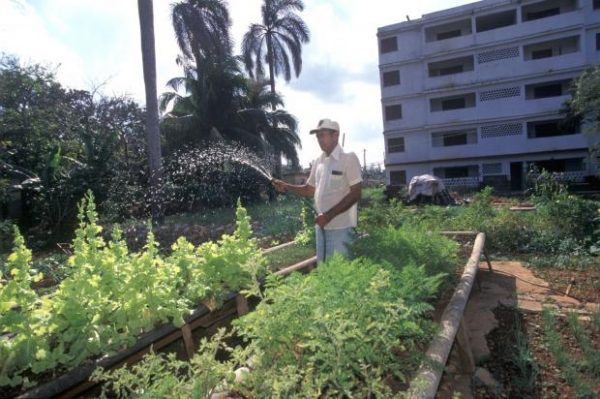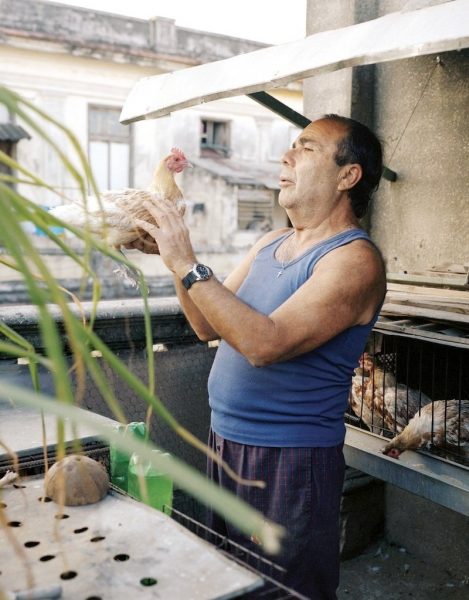Cuba’s Urban Agriculture and Livestock Production
By Carlyle MacDuff

HAVANA TIMES – Following the implosion of the USSR in 1989/90, which previously gave major financial and economic support to Cuba, Fidel Castro found it necessary to impose what he described as the “Special period”. This meant that Cuban’s had to further tighten their belts and not only survive on reduced rations, but find means of obtaining additional funds to extend those rations with purchases on the ilicit market, which still forms an essential component of Cuba’s economy.
The Castro regime ever cunning in converting a liability into an asset, honed in upon the need for the urban community to develop what during the Second World War were described in the UK as allotments. In Cuba they call them “urban agriculture” and take visiting overseas groups on tours to see their benefits. The major product of this urban agriculture is lettuce of rapidly wilting varieties rather than cos types, produced on raised beds.
Although thus displaying the horticultural side of urban agriculture, the regime fails to take the tours to visit urban livestock producers of whom there are many thousands and are economically more important.
Their major product is pork from pigs kept in fairly unsavory conditions in the small backyards behind the ramshackle homes. Usually kept in sties made with concrete block walls and rough metal roofing, the pigs are when adult, then sold to those who sell pork for a living from their front porch having been slaughtered by having their throats slit.

In addition to the pigs, a few hens and cockerels – some used for illegal cock fighting, peck around and a fortunate few Cubans keep a horse to pull their little sulkies as family transport. Keeping guard over the assorted livestock there will be a dog chained permanently to an old oil drum as a kennel.
The consequences of such livestock urban agriculture are that the urban neighbors are not only subject to that unmistakable rural farmyard stench, but to the squeal of the pigs, the crowing of the cockerels and the incessant barking of the miserable curs.
This is particularly noticeable during the evening and at night. Loudly crowing Cuban cockerels peculiarly seem to recognize midnight as the start of a new day with the piteous whimpering and howling of hungry dogs especially when there is rain, adding to the chorus.
There remains but one obvious question. Why doesn’t the regime demonstrate the livestock part of Cuba’s urban agriculture to visiting groups? Is it that they don’t wish to admit that their state system fails to supply sufficient protein, or do they not wish to disclose the pitiful conditions under which both the animals and the citizens co-exist?
Related Post: Urban Animal Farms in Havana






There’s nothing poor about Cuba it is Rich in intellectual currency.
Elite? Right and the 100 million that dictator Batista absconded with to Spain stealing money from the people.
Cuba is in ruins because of economic sanctions, people who leave that out really are either ignorant, liars or purposely want to cover up the misery that the campesinos lived under when Batista was in power.
And regarding this article the Cuban government is not cunning it is resourceful.
Nick is so intent upon his purpose of denigrating all that is related to his view of capitalism, that he misses the whole point of the article.
Other countries Nick, do not organize group tours of lettuce beds as if they are a unique conception emanating from communist thought. But, Cuba does!
It is undoubtedly factual that the livestock part of urban agriculture in Cuba is of greater economic significance than the lettuce beds. But it is not demonstrated!
That comparison obviously poses a question! The one which the article addresses, and which you chose to ignore.
I have visited only some thirty plus countries, and as an agriculturalist have noted – and in some studied, agricultural systems and methods, some as small scale as the Cuban lettuce beds. But, whereas there is for example, much to be learned from the Kibbutz of Israel and trickle irrigation, both horizontal and vertical (kohl rabi grown16 high, for shipping to Marks and Spencer) there is little to be learned agriculturally in Cuba and specifically from the much vaunted “urban agriculture”. That lack of initiative and progress in a country of historically proven agricultural potential is a consequence of the politically imposed system.
Even tiny enterprises can be the source of new concepts. In today’s world, virtually all supermarkets offer tomatoes “on the vine”. But the concept and introduction, was by a very small grower in the salt tolerant rashes at the southern end of the Dead Sea – back in 1991. I offer that as an illustration of progressive thinking and superb marketing initiated by an individual – the commercial capitalist world adopted.
Mention of Israel reminds me that Cuba markets the little that remains of its originally substantial citrus crop, through a capitalist company in Tel Aviv!
Nick, could it be that the Cuban Communist Party government has perfected the art of shooting yourself in the foot (or stomach in this case)? Remember everything that Fidel, Raul and company do is with good intentions while anti-popular policies in other countries are by the evil capitalists.
The key question that this clever article provokes is this:
Why does Mr MacD imply that a phenomenon is specific to Cuba when it is blatantly the case that this phenomenon is prevalent throughout many countries which are toward the bottom end of the capitalist ladder?
I think the answer is obvious.
The question remains unanswered!
A truly bizarre response Mr MacD.
Yet again you fail to read what I write. You fail to note the differentiation between those countries at the top of the capitalist ladder and those at the bottom.
Is England a third world country all of a sudden ?? Are cities such as Paris or Toronto in the third world ?? Not last time I checked.
If you travel across developing countries (formerly known as third world countries) you will frequently see similar scenes whereby livestock production takes place close to where people live. This is a fact. Most of these countries have some form of capitalist system. Also a fact.
But as usual Mr MacD does not like to let facts get in the way of a good story.
I think the article is clever.
There’s no sarcasm in my describing it as clever.
Praise would be praise indeed, were it backed with sincerity rather than displaying the lowest form of wit- ie that of sarcasm.
Nick however in his usual purpose of decrying capitalism -whilst simultaneously trying to deny that he favours extreme left wing socialism, is woefully ignorant regarding fact. Just consider for example, his sentence:
“The vast majority of urban livestock production on planet earth occurs not in countries which have a Cuban style ‘regime’, but in countries which have a Capitalist ‘regime’.
Absolute nonsense. Where does the urban livestock production in Nick’s native England occur? In London, Manchester, perhaps Birmingham, or in the rural countryside? Similarly, where does livestock production occur in the EU countries, and the north American countries? Paris, Berlin, perhaps Vienna, Madrid, New York and Toronto? Or in the respective countrysides?
I had not realized previously that Nick is a Vegan who obviously abhors all forms of meat. But he must have difficulty when in Cuba in living on vegetable products alone with no form of animal protein. No eggs, no pork, no chicken.
The article I wrote, is a realistic description of urban Cuba and of urban livestock production. The question I posed remains and maybe Nick knows the answer?
Why is it that the Castro regime through various channels, promotes only the growing of plants – particularly leafy lettuce to visiting groups, but fails to show them the more economically significant urban livestock production?
The article is not brilliant, but it is factual and the question is relevant.
This is a quite brilliant article which describes the realities of urban livestock rearing.
Most people would be familiar with the term ‘third world countries’. This term seems to have been gradually replaced by the terms such as ‘developing countries’.
Whatever terminology one wishes to use, the type of urban livestock production scenes lovingly described by Mr Mr MacD occur throughout these parts of the world.
The vast majority of urban livestock production on planet earth occurs not in countries which have a Cuban style ‘regime’ but in countries which have a Capitalist ‘regime’.
Now then, in your top of the ladder capitalist countries the stench, the squeals, the animal welfare issues etc all go on inside sealed units far from the public gaze. The only witnesses are generally speaking, low salaried often migrant labourers. High Security systems are in operation to prevent any public witnessing or filming of 21st century industrial scale meat production.
In countries further down that slippery old capitalist ladder there is typically far less concealment, less of the luxury of having the stench and the squealing locked away and separated from where folks live.
In much of the world life is more stark, more viscous, more ‘in yer face’ – the realities of livestock rearing are there for all to see (and sniff). Meat is not something which comes in neat little plastic packages in your local food retail centre. Meat comes from animal slaughter. This slaughter is seen, witnessed. The piglet is born. You feed it, watch it grow, fatten it up, cut it’s throat, eat it and sell it. A certain amount of mess, stench and noise is inevitably involved. These are facts of life. It ain’t hidden away. In fact many would say that it shouldn’t be hidden away but that’s different debate.
This article is brilliant in that the descriptions are vivid and accurate. It is also brilliant in the way it carefully attempts to plant the seed in the reader’s mind that this might even be something particular to Cuba or caused by some Cuban problem rather than being highly prevalent and utterly normal throughout much of the world.
Poor Havana from The Caribbean’s Paris to generalized vision of misery. The elite ya so small that can be fit in Cubanacan neighborhoods